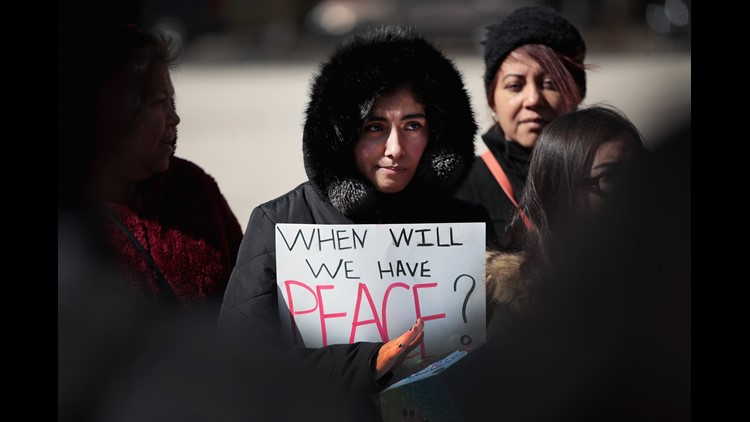A generation of students raised in the shadow of gun violence is sending a loud and united message to lawmakers: Enough is enough.
A month after a gunman killed 17 people at Florida’s Marjory Stoneman Douglas High School, students across the country demanded lawmakers set up measures to prevent another mass shooting.
In an unprecedented show of unity dubbed National Walkout Day, students put down their books and left class at 10 a.m. in each time zone for at least 17 minutes — one for each person killed at the Florida school.
Some students spelled out the word “Enough” on football fields with their bodies.
“We are tired of being scared to come to school,” said Ben Ramirez, a student in Los Angeles.
In some places, students chanted “Hey hey, ho ho! Gun violence has got to go!” In Washington, students sat in silence, their backs to the White House.
‘National movement of … future voters’
“Change is coming, change is here and change is here to stay,” David Hogg, a Stoneman Douglas student who survived the shooting, told CNN’s Anderson Cooper. “It shows that we have a national movement of young people, future voters … coming out and standing together with us.”
Democratic New York Gov. Andrew Cuomo, who lay down on the ground with protesters as part of a “die-in,” said he was inspired by the student-led movement.
“A new generation is rising, and they’re not afraid of the NRA,” he later tweeted. “America’s students can clearly see what the GOP cannot: weak gun laws are at the heart of America’s gun violence problem.”
Equipped with resolve and social media savvy, the students will gather again on March 24 for an event dubbed the March for Our Lives in Washington, where they’ll send a message to lawmakers up close. And more protests are planned for April 20, the anniversary of the Columbine High School massacre in Littleton, Colorado.
“This is not a matter of left versus right. This is a matter of public safety,” said Cate Whitman, a junior at LaGuardia High School in New York.
“We’re all working together, which is something we haven’t seen from the adults in a very long time.”
Defiance and action
While students marched Wednesday, the US House of Representatives passed a bill to fund more security at schools. The bill had bipartisan support, but it frustrated many Democrats due to its lack of any gun control measures.
“This is a pretense that we are doing something while assuring the NRA that we aren’t doing anything,” said Rep. Steny Hoyer of Maryland, the second ranking Democrat in the House.
Last week in Florida, the governor signed a bill named after Marjory Stoneman Douglas High. It raised the minimum age to purchase a firearm to 21, and the National Rifle Association quickly filed a lawsuit deeming it unconstitutional.
And in Illinois, the state Senate passed a bill that raises the legal age to buy assault weapons to 21.
The NRA reiterated its stance Wednesday, amid the protests.
“I’ll control my own guns, thank you,” it tweeted, along with a photo of an AR-15-style rifle, the same type of weapon used in last month’s massacre.
‘Be a nuisance’
In Parkland, Stoneman Douglas students rose before sunrise Wednesday to place hundreds of pinwheels around campus to mark the anniversary.
In a quote hung on a sign near the school, the environmentalist for whom the school is named tells students to “be a nuisance when it counts.”
The students appear to be heeding that advice. Initially organized by the Women’s March youth branch, the National Student Walkout on Wednesday demanded three key actions from Congress:
— Ban assault weapons;
— Require universal background checks before gun sales;
— Pass a gun violence restraining order law that would allow courts to disarm people who display warning signs of violent behavior.
Students sit out
Some students chose not to walk out with their classmates.
Austin Roth, a senior at Lapeer High School in Michigan, said he’s “100% supportive” of those who marched to honor victims of gun violence.
“However, I am not supportive of those who use a tragic event to push their political agendas, such as gun control,” he said.
The 17-year-old said he supports federal background checks and is “not completely against” raising the age to buy firearms. But he said he strongly disagrees with the notion of banning assault rifles, arguing they can be useful when confronted with multiple criminals.
“Guns are not the problem. The people are the problem,” Austin said.
In Minnesota, Noah Borba, 16, said he didn’t walk out because he’s unsure of the movement. He said he supports a ban on assault rifles, but he did not think it was logistically “realistic” to get rid of the assault rifles already out there.
“The movement seems too vague for my liking, and I would not like to associate myself with something I could end up disagreeing with in the future,” the Buffalo High School sophomore said.
In the Atlanta suburb of Cobb County, the school district said it would take disciplinary action against students who walked out, citing safety concerns. The punishment could range from Saturday school to five days’ suspension, per district guidelines.
That deterred some students, but not all of them, Pope High School senior Kara Litwin said. “Change never happens without backlash.”
In Littleton, a town put in the history books by the 1999 Columbine High School shooting, mass shootings especially resonate.
The Parkland massacre, nearly two decades later, shows politicians haven’t done enough, 16-year-old student Rachel Hill said.



